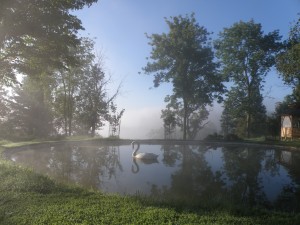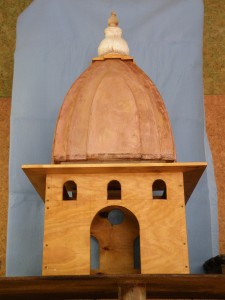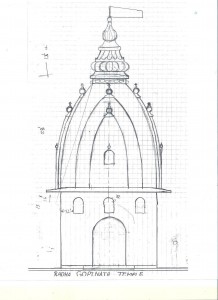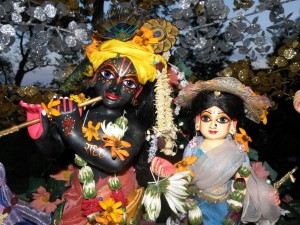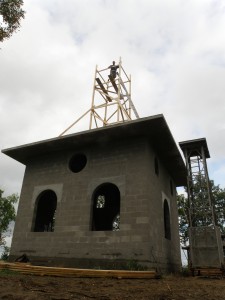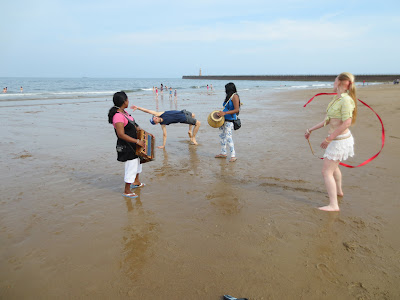But they are not. Its more bluffing from scientists whose modus is to get funding for useless research. http://bbc.in/165KjtY
BBC reports “Near death experiences explained.”
37 pics: More Matchless Gifts, August 12 2013, at Kings Cross, UK
→ Dandavats.com
 Dharmatma das: Another wonderful program last Friday evening. Lots of new guests and The Haris, a ladies bhajan group who led us in very nice Kirtan Read more ›
Dharmatma das: Another wonderful program last Friday evening. Lots of new guests and The Haris, a ladies bhajan group who led us in very nice Kirtan Read more › 38 pics: Last Day Of Padayatra at Cesky Krumlov, City of Czech Republic
→ Dandavats.com
 38 pics: Last Day Of Padayatra at Cesky Krumlov, City of Czech Republic Read more ›
38 pics: Last Day Of Padayatra at Cesky Krumlov, City of Czech Republic Read more › What Does Automatically Revealed Mean?
→ Dandavats.com
 Somehow, some of us might secretly feel the need to add (over-intelligent) to what Srila Prabhupada has already given us. Our thoughts could be, “This process requires too much patience… there must be a quicker way…” which subtracts from our Founder Acarya. How can we acknowledge the fullness of his teachings and what does it mean to have implicit faith in the spiritual master? Read more ›
Somehow, some of us might secretly feel the need to add (over-intelligent) to what Srila Prabhupada has already given us. Our thoughts could be, “This process requires too much patience… there must be a quicker way…” which subtracts from our Founder Acarya. How can we acknowledge the fullness of his teachings and what does it mean to have implicit faith in the spiritual master? Read more › 35 pics: Stormy Weather but the Show goes on!
→ Dandavats.com
 Indradyumna Swami: When a heavy rainstorm inundated our festival in Kolobrzeg most of the people in attendance left. But some remained... and for them the show went on. All glories to Lord Caitanya's samkirtan soldiers! Read more ›
Indradyumna Swami: When a heavy rainstorm inundated our festival in Kolobrzeg most of the people in attendance left. But some remained... and for them the show went on. All glories to Lord Caitanya's samkirtan soldiers! Read more › 125 pics: Palky Yatra ©ISKCON GOURADESH, Cologne, Germany
→ Dandavats.com
 125 pics: Palky Yatra ©ISKCON GOURADESH, Cologne, Germany Read more ›
125 pics: Palky Yatra ©ISKCON GOURADESH, Cologne, Germany Read more › 20130729 VedavyasaPriyaSwami
→ Gouranga TV - The Hare Krishna video collection
20130729 VedavyasaPriyaSwami
Nava Vraja Mahima Celebration
→ SivaramaSwami.com
See photos HERE
09.28 – Liberation is not just about what we are released from but also about what we are released to
→ The Spiritual Scientist
Patients admitted in a hospital long to be discharged so that they can return home and be with their loved ones. Even while staying in the hospital for as long as the treatment necessitates, they long for the release date, looking forward to all that they will be able to do thereafter.
Gita wisdom compares our present condition to a disease and the material world to a hospital. The symptoms of our disease are the fourfold problems of old age, disease, death and rebirth; and the threefold miseries coming from our body, our society and our environment.
People whose spiritual faculty starts awakening recognize the gravity of these miseries. Understanding that these miseries are inevitable at the material level of existence, they strive for release from it.
But their attempts are often sabotaged by their underdeveloped spiritual understanding. As they are not yet aware of the positivity of spiritual reality, their motivation for seeking liberation comes primarily from fear of the negativity of material reality. However, because material reality is seductive and deceptive, their spiritual determination frequently falters and falls, causing them to relapse to materialism.
The Bhagavad-gita (09.28) points to a deeper richer understanding of liberation that it refers to as vimukti. This special and full liberation releases us into a reality of love unending, of exciting and fulfilling reciprocations of love with the all-attractive Supreme Person Krishna. All our longings for love are perfectly and permanently satisfied when we learn to love him. And the process of devotional service helps us to love Krishna even while we are living in material existence. Those who practice devotional service diligently gain endearing glimpses of that love even in this life itself and eventually gain that life of love forever.
***
In this way you will be freed from bondage to work and its auspicious and inauspicious results. With your mind fixed on Me in this principle of renunciation, you will be liberated and come to Me.
01.08 – Attachment makes the absent present
→ The Spiritual Scientist
Attachment has the power to take our thoughts away from our surroundings to our dreams. It can make those to whom we are attached seem to be present even when they are absent.
This perception-transforming power of attachment is demonstrated at the start of the Gita. Therein, the arrogant prince Duryodhana assesses the comparative strengths of the assembled forces. After listing the prominent players on the Pandavas’ side (01.03-01.06), he refers to the leading lights on his side (01.07-01.11). In the Gita (01.08), he mentions Karna, the renowned archer who had a lifelong animosity towards Arjuna.
Duryodhana’s reference to Karna is intriguing because Karna was not present on the battlefield. Just before the start of the war, Karna had walked out of the Kuru forces in a huff due to what he perceived as a putdown of his prowess by the Kuru commander Bhishma. Karna refused to re-enter as long as Bhishma remained in charge.
Why then did Duryodhana refer to Karna? Because Karna was very much present in his mind. By his deft political maneuvering and shows of friendship, Duryodhana had won Karna over to his evil ways, thereby obscuring and perverting that famed archer’s virtues. As Karna shared his antipathy towards the Pandavas, Duryodhana was very attached to Karna. No wonder he felt the absent archer to be present.
Such is the vision-changing capacity of attachment. We can tap this capacity positively through devotional service. The more we become attached to Krishna, the more we can feel his presence in our heart to help us in life’s battles. And because Krishna being God is factually omnipresent, attachment to him takes us not from reality to illusion, but from temporary material reality to eternal spiritual reality – the arena to which we everlastingly belong.
***
There are personalities like you, Bhisma, Karna, Krpa, Asvatthama, Vikarna and the son of Somadatta called Bhurisrava, who are always victorious in battle.
Good Association Is King
→ Japa Group

Krishna consciousness is the path of light and liberation
→ The Spiritual Scientist
Maya means forgetfulness of Krishna, and forgetfulness of Krishna and Krishna consciousness stand side by side like light and shadow. If one remains in shadow, he cannot enjoy the facilities offered by light, and if one remains in light, he cannot be disturbed by the darkness of shadow. By taking to Krishna consciousness, one gradually becomes liberated and remains in light. Indeed, he does not even touch the darkness.
Unlimited Beauty
→ KKS Blog
(Kadamba Kanana Swami, 30 June 2013, Vrndavana, India, Srimad Bhagavatam 6.16.34)
 So this merciful aspect of Krsna is very important because the more we appreciate Krsna’s merciful nature, to be merciful says something about the state of the heart. So speaking here about the nature of Krsna’s heart. We can become attracted to Krsna’s beauty. Stunned by his unlimited beauty and just look at him again and again! His lotus eyes, his lotus feet, but the thing that capture me the most is Krsna’s merciful nature, because Krsna is unlimitedly kind. That naturally brings out love from the heart. We see how kind Krsna is! So it is important to contemplate Krsna’s merciful nature and to more and more appreciate how Krsna is merciful!
So this merciful aspect of Krsna is very important because the more we appreciate Krsna’s merciful nature, to be merciful says something about the state of the heart. So speaking here about the nature of Krsna’s heart. We can become attracted to Krsna’s beauty. Stunned by his unlimited beauty and just look at him again and again! His lotus eyes, his lotus feet, but the thing that capture me the most is Krsna’s merciful nature, because Krsna is unlimitedly kind. That naturally brings out love from the heart. We see how kind Krsna is! So it is important to contemplate Krsna’s merciful nature and to more and more appreciate how Krsna is merciful!
On Harinama Sankirtan with Mahavishnu Swami – Meaning of the Hare Krishna Chant…
→ Mahavishnu Swami
Aug. 8, ’13 Kirtan by Mahat
→ Krishna Lounge
Stormy Weather
→ travelingmonk.com
02.14 – Tolerance fosters not impotence but perseverance
→ The Spiritual Scientist
In spiritual life, tolerance is an important virtue. Internalizing this virtue may present us a dilemma: “If I just tolerate the things that happen to me, won't that make me weak, lethargic, impotent?”
Not at all, answers Gita wisdom. Far from making us impotent, tolerance will make us persistence.
To understand how, let’s look at the Bhagavad-gita’s call for tolerance in its context. The most-quoted mandate to tolerate comes in the Gita (02.14), which urges us to tolerate life's pleasures and pains just as we tolerate the heat and the cold. This verse is preceded (02.13) by the declaration that we are not destructible bodies, but are indestructible souls. And it is succeeded (02.15) by the proclamation that those who can tolerate attain eternal existence. The sandwich-like position of the tolerance verse indicates that it paves the path for us – the path from the information about our eternal nature in the previous verse to its realization in the next verse.
How does tolerance pave the path? When we train ourselves to tolerate the ups and downs of life, be they external like weather changes or internal like mood changes, then our mental energy doesn't get unduly dissipated on less important things. The greater our tolerance, the lesser our mental energy dissipation.
The conserved mental energy allows us to be focused on the process of yoga, connection with the supreme eternal reality, Krishna. The more we connect with Krishna, the more we become internally purified and illuminated, thereby gradually recognizing our eternal essence as souls. Thus, tolerance paves the path and devotional service moves us along the path.
So, tolerance is not about passively accepting whatever life dishes out to us, but about persistently refusing to let those dishes distract us and persevering in the primary purpose of our life.
**
Aug. 8, ’12 Kirtan by Jessica
→ Krishna Lounge
52 pics: Book Distribution Seminar & Harinam Sankirtan in Austin, TX
→ Dandavats.com
 HG Vaisesika dasa, ISKCON's North American Book Distribution Minister, was in Austin this past weekend 8/9 - 8/11 conducting a 2 day seminar on the importance of book distribution and the seminar participants held on a day of Sankirtan and distributed about 100 books in downtown Austin Read more ›
HG Vaisesika dasa, ISKCON's North American Book Distribution Minister, was in Austin this past weekend 8/9 - 8/11 conducting a 2 day seminar on the importance of book distribution and the seminar participants held on a day of Sankirtan and distributed about 100 books in downtown Austin Read more › 137 pics: Vaisnava Retreat @ Singapore
→ Dandavats.com
 Singapore was mesmerized by the blessings of Sri Dham Mayapur and Vrindavan devotees along with HH Bhakti Purosottam Swami@ August 8, 2013. Read more ›
Singapore was mesmerized by the blessings of Sri Dham Mayapur and Vrindavan devotees along with HH Bhakti Purosottam Swami@ August 8, 2013. Read more › “Modest Elegance”- An Interview with New Vrindaban’s Varsana Swami
→ Dandavats.com
 VARSANA M: Our Govardhana Hill project, featuring Radha Kunda and Syama Kunda as central landscape features, Radha Gopinath as the resident deity, and Their temple as the prime focus, derives inspiration and direction from a consistent thread interwoven through the fabric of Srila Prabhupada’s instructions, vision, and desire for New Vrindaban Read more ›
VARSANA M: Our Govardhana Hill project, featuring Radha Kunda and Syama Kunda as central landscape features, Radha Gopinath as the resident deity, and Their temple as the prime focus, derives inspiration and direction from a consistent thread interwoven through the fabric of Srila Prabhupada’s instructions, vision, and desire for New Vrindaban Read more › JIVA JAGO – Janmastami Newsletter – August 2013
→ Welcome to the official site of ISKCON Perth
“Modest Elegance”- An Interview with New Vrindaban’s Varsana Swami
→ New Vrindaban Brijabasi Spirit
“Modest Elegance” – An Interview with Varsana Maharaj
INTERVIEWER: Please describe your project to us, Maharaj.
VARSANA M: Our Govardhana Hill project, featuring Radha Kunda and Syama Kunda as central landscape features, Radha Gopinath as the resident deity, and Their temple as the prime focus, derives inspiration and direction from a consistent thread interwoven through the fabric of Srila Prabhupada’s instructions, vision, and desire for New Vrindaban.
Srila Prabhupada’s vision for New Vrindaban includes five main topics, one of which is holy pilgrimage. New Vrindaban is, of course, an ongoing and very important place of holy pilgrimage for many devotees and pilgrims all over the world. In addition, Srila Prabhupada had a specific vision, which we will discuss shortly, for exactly what he wanted to see in New Vrindaban as a place of pilgrimage, and that is what I am basing my project on. I was surprised to learn that many devotees were NOT aware that the “Seven temple on seven hills” concept was exclusively Srila Prabhupada’s idea! This explained to me why we weren’t attracting much support or participation for this first of the seven temples.
As a point of reference, and framework for understanding, consider Srila Prabhupada’s response to news of the potential for land in Appalachia. His response revealed an endearing aspect of his personality which is not readily apparent. He said something wonderful – “I have a fancy for your country,” he told Hayagriva, in his letter written from his residence at the Radha Damodara Mandir.
This was in 1968, the very first letter that Hayagriva received from Srila Prabhupada in India.
Srila Prabhupada went on: “I have a fancy for your country. And being inspired by that fancy, I went there first. Now, Krsna is blessing a nice piece of land which resembles Vrindaban, to be a new place of pilgrimage for you western devotees. If turned into New Vrindaban, I shall forget to return to India!”
And later, “Now I’m trying to return to the United States as soon as possible.”
These words of Srila Prabhupada are both very clear and revealing.
Later that same year, Srila Prabhupada wrote again to Hayagriva.
“Because I’m getting older, and if any time you take me to your new hermitage, I will be glad to go there, and finish my life translating Srimad Bhagavatam and the Goswamis’ literatures.”
<<>>
INTERVIEWER: Wow. There are probably a lot of devotees who were not aware of these letters.
VARSANA M: There is more! That same year, 1968, Kirtanananda and Hayagriva went to Montreal to see Srila Prabhupada. They explained to him that New Vrindaban has long roads and is quite hilly. Srila Prabhupada replied that it is better to use horse and wagon than jeep. Then he became very specific.
“All the hills and temples should be named after the goswamis’ temples in Vrindaban.” Then Srila Prabhupada’s eyes became wide with the anticipation of seeing these temples manifest. He went on, ““Rename the hills Govardhan. If there are lakes, name them Syama Kunda and Radha Kunda.” “Vrindaban is a transcendental village completely dependent on nature’s beauty and protection. Therefore dedicate yourselves to plain living and high thinking.”
These ideas are what I base my project on. Of course, I, personally, have no money or manpower, but this project is definitely taking on a life of its own and receiving support from our family of devotees.”
<<>>
INTERVIEWER: Why Radha Kunda and Syama Kunda? Why does Srila Prabhupada say it’s important to name the lakes Radha Kunda and Syama Kunda, after the original lakes in Braja?
VARSANA M: The answer is both profound and practical. When Lord Gauranga went to Vrindaban, He asked “Where is Radha Kunda? Where is Syama Kunda?” He saw these sacred ponds as crucial to His mission.
The waters of Radha Kunda infuse the soul with a love for Krsna similar to Radha’s, and, similarly, the waters of Syama Kunda infuse the soul with love of Radha similar to what Krsna feels for Her.
Lord Gauranga and Srila Prabhupda know that these kundas are instrumental in perfecting our chanting. The acaryas tell us that having access to these ponds is very significant in developing a taste for the holy name. It’s not just abstract. It’s very concrete in developing our love for Krsna through hearing and chanting.
These are very humble beginnings. Eventually, it will be a demonstration of modest elegance.
<<>>
INTERVIEWER: Maharaja, please tell us a bit about the Temple building itself.
VARSANA M: The temple itself will be 50 feet high with a dome on top. The temple is being fashioned, in a simpler way, after Madhu Pandit’s first and original Radha Gopinath Mandir in Vrindaban, before it was desecrated by marauding Moghul iconoclasts.
The community celebrated Radhastami in 2012 inside the walls of the new Radha Gopinath temple, as we revealed completion of the first phase of construction, and this was the turning point, when it became acceptable in people’s eyes.
To honor Srila Prabhupada’s words, desire, and vision, it is crucial that my generation complete at least the first of the seven temples that Srila Prabhupda wanted for New Vrindaban, in our lifetime.
Everything here is arranged according to the terrestrial features of the original Vrindaban.
This model that you see is for design purposes only. We do not have 3-D CAD (Computer Aided Design) ability on our computers, so this is not exactly what the finished temple will look like. This is a model of the basic shape and design of the temple. Many more embellishments will adorn the outside of the temple.
<<>>
INTERVIEWER: We know that Josef has been doing a great job guiding parikrama parties from the temple to the Radha Gopinath Hill here. Can you elaborate on that aspect?
VARSANA M: Yes, he certainly has. But he needs some place markers and written stories. And he needs signs which mark the way, in order to execute the parikrama following the proper protocol, which is as follows, just as it is in Vrindaban.
You begin at Kusum Sarovara (swan lake) at the foot of Govardhan Hill, then you pass the big Gaura Nitai statues, Who are inviting and blessing pilgrims to follow Their footsteps.
Then you come to Manasa Ganga, a small version of which we excavated this year. The parikrama path curves up the hill, where you go to Lalita Kunda, then to the rock temple of Kundesvara Mahadeva Siva, and finally to the Gopinathji temple.
The central features are Radha Kunda, with its guardian swan floating upon Her waters; next is Syama Kunda, which is surrounded by the kundas of the sakhas, of which Sridama Kunda is already manifest.
There are smaller parikrama paths within the larger one. They all end at the Gopinath Mandir.
You can also turn onto the path to Prabhupada’s Palace if you’d like, which, spiritually, brings everything full circle. These are some of the many options depending on the time you have, the weather, if you’re in a wheelchair, etc.
<<>>
INTERVIEWER: I know there are people who would love to help with this project. How can they do that?
VARSANA M: We need signs that describe each place on the paths, as well as direction signs to clearly point out the different parikrama paths.
I’ve already written up many meditations for each of the holy places for which we need volunteers with literary and computer skills to accomplish the task of publishing, laminating and posting all of these stories.
All the material is there; it just needs to be coordinated. There are people already working on this who could use help.
As far as physical help, there are plenty of landscape opportunities.
So the modest elegance of the Radha Gopinath project has reached the stage of being appreciated. The larger aspiration is encouraging people to appreciate New Vrindaban in general.
<<>>
INTERVIEWER: Why did you choose this particular design for the temple? Can you please give us some kind of historical perspective on that?
VARSANA M: The design closely resembles the original Radha Gopinath Mandir inspired by Madhu Pandit, who is entrusted with the care of the original Radha Gopinath deities, who were installed by Vajranabha, Krsna’s great grandson!
His sponsor was Rayasila Shekhavata who was granted land by Akbar in appreciation of his defeating the Afghans.
It is commonly accepted that Radha Gopinath Mandir was built before Madan Mohan and Radha Govinda temples.
<<>>
INTERVIEWER: Some people have asked if you know whatever happened to the same Ananta Sesa who was installed in the cornerstone of the Govindaji Temple.
VARSANA M: There’s a story behind that one! Ananta Sesa, who rests in the N.E. cornerstone of this temple, was first installed in 1973 for the foundation of the Govinda temple, which was never built. The cornerstone was relocated to the Temple of Understanding, which was also never built. At last the cornerstone ended up here, where, one day, in the middle of a Kartik lecture, I saw Ananta Sesa looking out from a hole which had developed in the cornerstone over time. I took this as a sign that He needed and wanted to take up the rightful position in the footer of a temple that would be built upon His hoods, which uphold the entire creation, after 39 years of living within a cornerstone that was repeated being moved!
<<>>
INTERVIEWER: So THAT’S where Ananta Sesa ended up! Ecstatic! There are a lot of exciting things going on up at your place, I see. Maharaja, is there anything else you’d like to say about the Radha Gopinath Mandir project?
VARSANA M: For Srila Prabhupada, the jagat guru, spiritual master of the universe, home means Vrindaban – nowhere else. And that is what constitutes the Holy Dhama – the presence of the acarya who carries Krsna in his heart and can thus install Him anywhere.
It is not our own endeavors to build temples, excavate kundas, and rename tracts of land according to their facsimiles in Vraja. It is the presence of Srila Prabhupada that makes this place, in his own words, “non-different from Vrindaban.”
Srila Prabhupada affirmed that he had indeed taken up residence in the Palace, which is his Samadhi, where sincere sadhakas can take up and develop their ongoing relationship of service with him.
Our Govardhana Hill project and the Radha Gopinath temple are for the purpose of complimenting the Palace grounds according to Srila Prabhupada’s vision, a replica of Vrindaban, to assure his pleasure of feeling at home.
It was a blissfully busy Sunday!
→ SivaramaSwami.com
Sunday the 11th celebration kirtan
→ SivaramaSwami.com
Nava-varja Mahima English is finished.
Srila Prabhupada explains why cooperation is the essence of the movement
→ Dandavats.com
 Caitanya Mahaprabhu Himself wanted our cooperation. He is God, Krsna. Therefore cooperation is very important thing. Nobody should think that ‘I have got so great ability. I can do.’ No. It is simply by cooperation we can do very big thing. ‘United we stand; divided we fall.’ So be strong in pushing on Krsna consciousness, and Krsna will help. He is the strongest.
Read more ›
Caitanya Mahaprabhu Himself wanted our cooperation. He is God, Krsna. Therefore cooperation is very important thing. Nobody should think that ‘I have got so great ability. I can do.’ No. It is simply by cooperation we can do very big thing. ‘United we stand; divided we fall.’ So be strong in pushing on Krsna consciousness, and Krsna will help. He is the strongest.
Read more › BGIS, Vrindavan – A Spiritual Journey to the Himalayas
→ Dandavats.com
 When a group of 40 teachers and staff members of Bhaktivedanta Gurukula and International school started their journey to Alaknanda, little did they know that it would turn out to be one of the most learning and spiritual experiences of their lives Read more ›
When a group of 40 teachers and staff members of Bhaktivedanta Gurukula and International school started their journey to Alaknanda, little did they know that it would turn out to be one of the most learning and spiritual experiences of their lives Read more › New Artist Joins the TOVP
- TOVP.org
The TOVP attracts people from around the world who would like to offer their talents and expertise to the project.
The latest gentleman to join the team is American artist, Edward Breathitt. A native of Kentucky, Mr. Breathitt is now based in New Delhi where he runs his own business creating beautiful art for public and private commissions. He first came to India as a young spiritual seeker, feeling the need to dive deeper into the knowledge this land offered. He also studied the architecture of Indian temples and became absorbed in their ornate beauty. He began dividing his time between India and the USA until his stays in India became longer in duration. In 2004 he met a lovely Indian woman who became his wife in 2008. They now have a beautiful daughter together.
Mr. Breathitt recently visited Mayapur and was immediately spellbound by its natural opulence and energy. He spent a few days in discussions with the artists at the TOVP and they agreed that he would help with the sculpting. While he was here, he worked on a bust of Srila Prabhupada as a gift to the TOVP. Of his experience, he said that working with clay from the Ganga on such a significant piece of art felt like a gift and that the quality of his work felt strong.
We appreciate his talent and enthusiasm. We are happy he has found a place with us and we are eager for his next visit.
5 pics: New Artist Joins the TOVP
→ Dandavats.com
 Sadbhuja Das: The TOVP attracts people from around the world who would like to offer their talents and expertise to the project. The latest gentleman to join the team is American artist, Edward Breathitt Read more ›
Sadbhuja Das: The TOVP attracts people from around the world who would like to offer their talents and expertise to the project. The latest gentleman to join the team is American artist, Edward Breathitt Read more › 55 pics: Twenty-Eight Down, Twenty To Go!
→ Dandavats.com
 55 pics: Twenty-Eight Down, Twenty To Go! Read more ›
55 pics: Twenty-Eight Down, Twenty To Go! Read more › HH Bhakti Vidya Purna Maharaja, Soho, London
→ Gouranga TV - The Hare Krishna video collection
HH Bhakti Vidya Purna Maharaja, Soho, London
30 pics: Vancouver Ratha Yatra, August 11, 2013
→ Dandavats.com
 30 pics: Vancouver Ratha Yatra, August 11, 2013 Read more ›
30 pics: Vancouver Ratha Yatra, August 11, 2013 Read more › 364 pics: Jagannath Rathayatra, Birmingham, UK August 11, 2013
→ Dandavats.com
 364 pics: Jagannath Rathayatra, Birmingham, UK August 11, 2013 Read more ›
364 pics: Jagannath Rathayatra, Birmingham, UK August 11, 2013 Read more › ISKCON Scarborough – Pastimes of Thirumazhizai Alwar – Bhagavad Gita 5.24
→ ISKCON Scarborough
Deity Darshan: 8/10/2013
→ The Toronto Hare Krishna Blog!
While The Body Is Fit
→ Japa Group
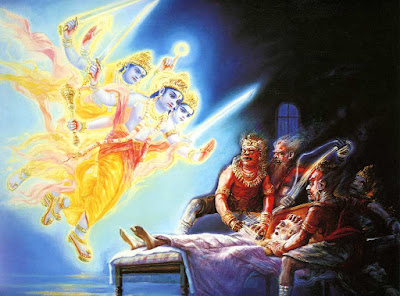
"While the body is fit, therefore, why should we not chant the holy name loudly and distinctly? If one does so it is quite possible that even at the time of death, he will properly be able to chant the holy name of the Lord with love and faith."
Śrīmad Bhāgavatam 6.2.49 purport
What really counts
→ KKS Blog
(Kadamba Kanana Swami, 20 July 2013, Cape Town, South Africa, Spirit Matters Program)
 Even when we are so transcendental ourselves, we still have to take people’s feelings very serious, even if they are partially motivated by false ego - it doesn’t matter, just like a child. But when you are an adult, you see it different although a father leaving home is not a small thing; that is real suffering but what can be done!?
Even when we are so transcendental ourselves, we still have to take people’s feelings very serious, even if they are partially motivated by false ego - it doesn’t matter, just like a child. But when you are an adult, you see it different although a father leaving home is not a small thing; that is real suffering but what can be done!?
When I was a kid, I lost my favourite toy car in a sand-pit; I never got over it. It was a big thing. I dug up the whole sand-pit and sifted through the whole thing but never found my little golden Jaguar, as it was called. What a drama it was!
Now, of course, I look at it a little bit different but my little golden Jaguar stands there to remind me that for me, that was a very important thing. So, what really counts is what is really important to people. I don’t think that we should go around and put labels on people and say, “False ego!”
I think that we should take serious what is serious to others otherwise how will they take us serious. If I am so transcendental that I don’t take anybody serious, that doesn’t make sense at all. Then I become cold and disinterested from people.
Like Prabhupada, he was very transcendental yet he could be very human with human beings. He was able to come down to what moved people although it didn’t move him in the same way.
Chanting is both easy and beneficial
→ The Spiritual Scientist
To cleanse the mind and heart from all misconceptions, one should take to this chanting of the Hare Krishna maha-mantra. This is both easy and beneficial.
14 pics: Harinama in Mayapur, 11/08/2013
→ Dandavats.com
 14 pics: Harinama in Mayapur, 11/08/2013 Read more ›
14 pics: Harinama in Mayapur, 11/08/2013 Read more › Travel Journal#9.13: The North of England
→ Travel Adventures of a Krishna Monk
By Krishna-kripa das
(July 2013, part one)
(Sent from Bratislava, Slovakia, on August 11, 2013)
Aside from the beaches in Florida and Poland, I rarely do harinama on the beaches, but the weather was so excellent, a rarity in The North of England, that Lauris and Malvika suggested that we chant at the Roker Beach in Sunderland. Diya decided to join us, even though she is a little shy to chant in her hometown, and we were very happy she came.
“When a devotee is eager to see the Supreme Personality of Godhead, he prays to the Lord:
worried that my poem to Radha-Govinda
is repetitious.
Pujari service is the same, but there is always
variety of dresses, ornaments,
flowers andprasadam.
Even the sameness
is a steadying influence
as we get to know
Them better every day. In
the spiritual world
Radha and Krishna play the same sports
in Their asta-kaliya
lila throughout the hours of the day and night.
But there are always newer and ever-fresh rasas as experienced by Them.
I don’t want any extraordinary change.
I just want to see Them as
They are. As I grow in devotion,
the change will take place in my heart.
a submissive
hearer of Srimad-Bhagavatam and pass his
days in enlightened hearing.
yac-chaktayo vadatam vadinam vai




